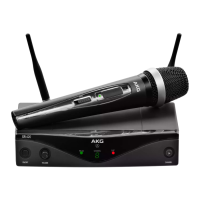Also read the transmitter and receiver manuals!
1. Turngaìncontrol
down CCW.
2. ConnectalO-dB
preattenuation pad
between
m¡crophone
cable and
input.
1. Gain control on the
mixer set too high.
2. Mixer input sensitivity
too high.
Distortion:
1. Switch
powerto
mixer
or amplifier
on.
2. Setchannelormas-
ter fader
on mixer or
volume control on
amplifier
to desired
level.
3. Connect
microphone
to mixer
or amplifier.
4. Check
cable connec-
tors for secure seat.
5. Checkcableandre-
place
if damaged.
6. Switch
phantom
power
on.
Phantom
power
sup-
ply:
connect
to
power
outlet
or insert bat-
tery
(batteries).
Check
cable and re-
place
if necessary.
1. Powertomixer
and/or
amplifier is off.
2. Channel ormaster
fader on mixer, or
vol-
ume
control on am-
plifier
is at zero,
3. Microphone is noi
connected
to mixer
or amplifier.
4.
Cableconnectorsare
seated loosely.
5. Cable
is defective.
6. No supply voltage.
No
sound:
Remedy
Possible CauseProblem
Tvoe:
pre-polarized
condenser microphone
Polar
cardioid
Frequency range: 80 Hz to
20,000 Hz
Sensitivity: 35 mV/Pa
(-46
dBV re 1 V/Pa)
Electrical lmpedance at 1000 Hz: <
200 ohms
Recommended load impedance:
> 2000
ohms
Max.
SPLfor
1% / 3%THD:
126d8/130d8
Equivalent noise level: 22
dB(A) to IEC
60268-4
Supply voltage:
B 29 L battery
supply, MPAV L
phantom
power
adapte¡ or AKG WMS bodypack
transm¡tter
Current consumption:
approx. 2 mA
Cable length/Connector:
1.5 m
(5
ft.)
/
3-pin
mini XLR
Finish:
matte black
Size
(microphone
only): length:
195 mm
(7.7
ìn.);
max. dia.:
134 mm
(5.3
ìn.)
Net weight
(microphone
l/cable):
26
g (0.9
oz.)
Shipping weight
260
g
(9.2
oz.)
This
product
conforms
to the standards
listed in the Declarat¡on
of Conformity.
To
order a
free
copy of the Declaration
of Conformity,
visit http://www.akg.com
or contact .com.
Frequency
Response
Polar Diagram
AKG C 555 L
AKG C 555
L
21
20

